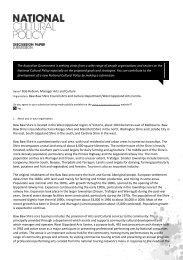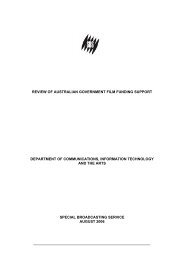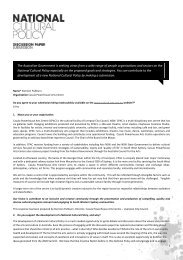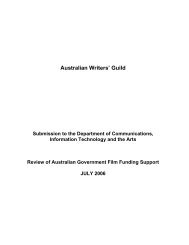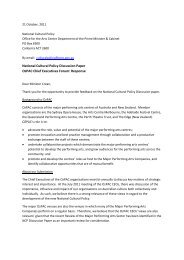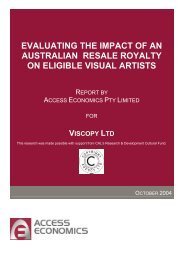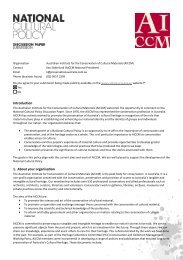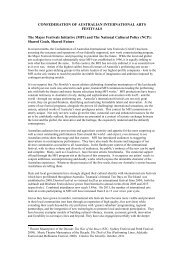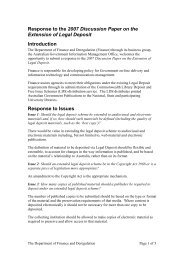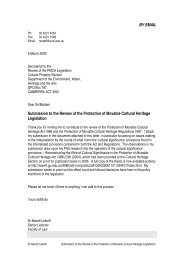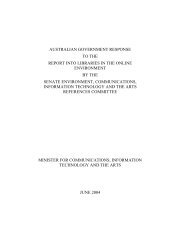National Association for the Visual Arts
National Association for the Visual Arts
National Association for the Visual Arts
Create successful ePaper yourself
Turn your PDF publications into a flip-book with our unique Google optimized e-Paper software.
RESALE ROYALTY SUBMISSIONThe <strong>National</strong> <strong>Association</strong> <strong>for</strong> <strong>the</strong> <strong>Visual</strong> <strong>Arts</strong> (NAVA) is pleased torespond to <strong>the</strong> Proposed Resale Royalty Arrangement discussion paperprepared <strong>for</strong> <strong>the</strong> Government by <strong>the</strong> Department <strong>for</strong> Communications,In<strong>for</strong>mation Technology and <strong>the</strong> <strong>Arts</strong> (DCITA). It is hoped that <strong>the</strong>DCITA paper will contribute fur<strong>the</strong>r to <strong>the</strong> process of soliciting evidencefrom <strong>the</strong> sector which will encourage <strong>the</strong> government to proceed withlegislating this long awaited artists' right.NAVA is <strong>the</strong> peak body representing and advancing <strong>the</strong> professionalinterests of <strong>the</strong> Australian visual arts and craft sector. Since itsestablishment in 1983, NAVA has been a powerful <strong>for</strong>ce in bringingabout policy and legislative change to encourage <strong>the</strong> growth anddevelopment of <strong>the</strong> visual arts and craft sector and to increaseprofessionalism within <strong>the</strong> industry. It has also provided direct service to<strong>the</strong> sector and its members (approximately 3000) through offering expertadvice, representation, resources and a range of o<strong>the</strong>r services.For about fifteen years, NAVA has been advocating <strong>for</strong> <strong>the</strong> introductionof <strong>the</strong> artists’ resale right in Australia and in <strong>the</strong> recent past has joinedwith <strong>the</strong> Australian Copyright Council, <strong>the</strong> <strong>Arts</strong> Law Centre of Australiaand Viscopy to provide expert advice and prepare submissions on <strong>the</strong>issue <strong>for</strong> all political parties, most recently in November 2003. NAVAcontinues to support <strong>the</strong> position put <strong>for</strong>ward in <strong>the</strong> latest submission butwith some fur<strong>the</strong>r elaboration in <strong>the</strong> answers provided below.NAVA was gratified that <strong>the</strong> report of <strong>the</strong> government’s Myer Inquiryinto <strong>the</strong> Contemporary <strong>Visual</strong> <strong>Arts</strong> and Craft Sector (2002) recommended<strong>the</strong> introduction of <strong>the</strong> resale right, and has been encouraged by <strong>the</strong>government’s evident interest. NAVA believes that it is now time to takeaction.What is Resale RoyaltyAs described by Silke Radde 1 <strong>the</strong> resale royalty is an economic right,which takes <strong>the</strong> <strong>for</strong>m of a collection of a sum of money on each resale ofart works, to be paid to <strong>the</strong> artist giving <strong>the</strong>m <strong>the</strong> right to participate in <strong>the</strong>future economic exploitation of <strong>the</strong>ir work. It also has some of <strong>the</strong>characteristics of a moral right, " a derivative of ...<strong>the</strong> inalienable right of1 Radde S. (May 2001) "droit de suite: <strong>the</strong> artist's right to a resale royalty and <strong>the</strong>implications <strong>for</strong> New Zealand" pg 354 - 364, Intellectual Property Journal
paternity", positing a personal relationship between <strong>the</strong> artist and his orher creation, which acknowledges that art is a continuing projection of <strong>the</strong>artist's personality.1. Should Australia introduce a resale royalty arrangement?What are your primary reasons <strong>for</strong> your support or lack ofsupport <strong>for</strong> such an arrangement?The <strong>National</strong> <strong>Association</strong> <strong>for</strong> <strong>the</strong> <strong>Visual</strong> <strong>Arts</strong> (NAVA) strongly supports<strong>the</strong> introduction of artists’ resale royalty legislation in Australia and hasbeen increasingly pressing <strong>the</strong> federal government to make a commitmentthrough legislating <strong>the</strong> right and supporting <strong>the</strong> implementation ofadministrative arrangements to see it take effect. This recommendation<strong>for</strong>med part of NAVA's submission to <strong>the</strong> Myer Inquiry into <strong>the</strong>Contemporary <strong>Visual</strong> <strong>Arts</strong> and Craft Sector.NAVA supports it <strong>for</strong> all <strong>the</strong> reasons canvassed in <strong>the</strong> DCITA discussionpaper.In Australia, artists gradually are being granted <strong>the</strong> rights enjoyed byartists in many o<strong>the</strong>r countries, particularly in <strong>the</strong> UK and Europe. In thiscase <strong>the</strong> introduction of resale royalty would follow in <strong>the</strong> footsteps of itsadoption by <strong>the</strong> whole of <strong>the</strong> European Union to be implemented by 2006(though later in <strong>the</strong> UK). This will fulfil Australia's obligations as asignatory to <strong>the</strong> Berne Convention.Comparable right to o<strong>the</strong>r art<strong>for</strong>msIt is similar in significance and intention to <strong>the</strong> royalties regime inoperation <strong>for</strong> creators in o<strong>the</strong>r disciplines like writing and music.However <strong>the</strong>re are differences between <strong>the</strong> economies of <strong>the</strong> various artmediums to <strong>the</strong> extent that, in <strong>the</strong> o<strong>the</strong>r disciplines small levies can beimposed on <strong>the</strong> sale of multiple copies of literary or musical works, whilevisual and craft artists have only one opportunity to earn income fromsale of <strong>the</strong> original. By means of <strong>the</strong> resale royalty, artists can benefitfrom <strong>the</strong> successive uses of <strong>the</strong>ir artworks as <strong>the</strong>y are passed from oneowner to ano<strong>the</strong>r, taking a small percentage contribution at each point ofexchange. Gradually over <strong>the</strong> life of <strong>the</strong> artist and his/her descendants, <strong>the</strong>incremental amounts could be regarded as a repayment to <strong>the</strong> artist <strong>for</strong> <strong>the</strong>enjoyment of his or her work by purchasers, and recognition of <strong>the</strong> artist'sgrowing reputation. (This of course is separate from, but in some wayssimilar to <strong>the</strong> income all copyright owners can earn from licensing <strong>the</strong>reproduction of <strong>the</strong>ir work).
Recognition of professional statusAs a group, artists are better educated than <strong>the</strong> general community andcould be better remunerated by choosing different professional careerpaths. However, <strong>the</strong>ir commitment to <strong>the</strong>ir artistic practice is usuallygreater than <strong>the</strong>ir desire <strong>for</strong> wealth. This does not mean that <strong>the</strong>y do notwish to be well paid <strong>for</strong> <strong>the</strong>ir artwork. On <strong>the</strong> contrary, most greatlydesire <strong>the</strong> recognition that high prices <strong>for</strong> <strong>the</strong>ir artwork would imply.Over <strong>the</strong>ir lifetimes, artists dedicate <strong>the</strong>mselves to <strong>the</strong> building of <strong>the</strong>irartistic reputations. The payment of resale royalties would be one muchvalued <strong>for</strong>m of recognition of <strong>the</strong>ir professional status.Long term financial viabilitySince <strong>the</strong> earnings of most artists from first sale of <strong>the</strong>ir works arerelatively small, particularly in <strong>the</strong>ir early establishment years, <strong>the</strong>y areoften not in a position to contribute to superannuation schemes. Resaleroyalty earnings paid later in <strong>the</strong>ir lives are one way in which <strong>the</strong>y cangain value from <strong>the</strong>ir earlier ef<strong>for</strong>ts and financial sacrifices.The recently published Throsby and Hollister 2 report has revealed thatmany artists live below <strong>the</strong> poverty line. While it is probable that <strong>the</strong>rewould be great variation in <strong>the</strong> level of income support received by artistsfrom this source, <strong>for</strong> people on limited incomes, even relatively smallamounts of money can make a very welcome contribution to <strong>the</strong>irwellbeing and that of <strong>the</strong>ir families.It seems grossly unfair that everyone else involved in trading andexhibiting <strong>the</strong> work of artists gains benefits, while <strong>the</strong> creators of <strong>the</strong>work stay at <strong>the</strong> bottom of <strong>the</strong> food chain. This resale right would giveartists some small proportion of <strong>the</strong>se benefits.2. What should be <strong>the</strong> primary objectives of a resale royaltyarrangement in <strong>the</strong> Australian environment?The primary objective is to provide a new income stream <strong>for</strong> artists whichis a direct product of <strong>the</strong>ir creative output, and respect <strong>for</strong> andacknowledgement of artists’ continuing interest in <strong>the</strong>ir work.NAVA asserts that this scheme alone does not provide <strong>the</strong> sole answer toartists need <strong>for</strong> professional respect and income, but it is both a powerfulsymbolic <strong>for</strong>m of recognition and provides a valuable income stream. It is2 Throsby D. and Hollister V. (2003) Don’t Give Up Your Day Job: an EconomicStudy of Professional Artists in Australia
one of several <strong>for</strong>ms of support and acknowledgement, which toge<strong>the</strong>rcan give artists <strong>the</strong> means and incentive to conduct <strong>the</strong>ir practice.The Throsby and Hollister report 3 provides <strong>the</strong> extremely worryingevidence that over at least <strong>the</strong> fifteen year period of <strong>the</strong> surveys, visualartists’ incomes have been steadily dropping, and comparatively morethan <strong>the</strong> average wage earner. While this was also true <strong>for</strong> o<strong>the</strong>r creatorsuntil <strong>the</strong> early 90s, <strong>the</strong> incomes of professionals in o<strong>the</strong>r art<strong>for</strong>m areasbegan to rise again. Sadly this is not <strong>the</strong> case <strong>for</strong> visual and craft artists.In 2000/1, <strong>the</strong> most recent period surveyed, 22% of visual artists and 19%of craft practitioners earned less than $10,000 income from all sources.The median income of visual artist was $22,900 with $3,100 coming from<strong>the</strong>ir art practice, and $22,600 <strong>for</strong> craft practitioners with $8,200 comingfrom <strong>the</strong>ir craft practice. With median expenditure on visual arts practiceof $4,400 and $7,000 <strong>for</strong> craft, many creators are making very smallprofits, if any. When artists’ incomes are compared with those of o<strong>the</strong>rfull time employed professional people earning a median income of$48,900, <strong>the</strong> difference becomes starkly clear. Artists are earning lessthan half <strong>the</strong> income of <strong>the</strong> average professional.Alongside this, <strong>the</strong> auction market has significantly increased its profitsover <strong>the</strong> last 10 years (as detailed in <strong>the</strong> DCITA discussion paper)indicating that <strong>the</strong> improving art economy can well af<strong>for</strong>d to make acontribution to artists’ financial viability.3. Who do you consider should be <strong>the</strong> principal targets of aresale royalty arrangement and why?The principal targets of <strong>the</strong> resale royalty arrangement would be allAustralian artists whose artistic works are resold and <strong>the</strong>ir heirs. Just asany one else’s heirs have <strong>the</strong> right to benefit from <strong>the</strong>ir benefactors’ability to build <strong>the</strong>ir estates, so too should <strong>the</strong> heirs of artists who havemanaged to achieve financial success.NAVA is of <strong>the</strong> view that <strong>the</strong> royalty right should not be based on needalone, but is a right similar to moral rights and should be viewed as anentitlement <strong>for</strong> all visual artists and craft practitioners regardless of <strong>the</strong>irchosen medium of expression. Some suggest that <strong>the</strong> right should onlyapply to Aboriginal artists, however this is not a view shared by NAVA,3 ibid
not <strong>the</strong> least because it is discriminatory and would be extremelyproblematic to administer.The Lawson Menzies auction house has establishes a resale scheme <strong>for</strong>Indigenous artists based on a 2% royalty with <strong>the</strong> collected paymentspooled and distributed to Indigenous communities <strong>for</strong> welfare purposes.NAVA regards this as patronising and inappropriate. The decision toshare <strong>the</strong> benefits of payment with <strong>the</strong> community should be made by <strong>the</strong>artist. In detaching <strong>the</strong> royalty from individual artists, it no longerrecognises <strong>the</strong> on-going connection between <strong>the</strong> artist and his or herwork.4. What kind of resale royalty arrangement would best deliverbenefits to <strong>the</strong> intended beneficiaries and why?• a fully legislated scheme;• industry self-regulation; or• contract-based resale royalty?4.1 Fully legislatedNAVA submits that a fully legislated scheme is <strong>the</strong> only reliable way todeliver <strong>the</strong>se benefits to Australian artists, given <strong>the</strong> power differentialsbetween visual arts and craft practitioners and <strong>the</strong> principle intermediarybodies reselling <strong>the</strong>ir work. NAVA’s proposal is <strong>for</strong> a fully legislatedinalienable right <strong>for</strong> all sales of Australian artists’ work to beadministered by a declared collecting society. This should go to tenderand we would propose that relevant arts industry bodies like NAVAshould be involved in <strong>the</strong> process of developing <strong>the</strong> tender criteria and berepresented on <strong>the</strong> selection panel.We also note that signatories to <strong>the</strong> Berne Convention which haveintroduced resale royalties have incorporated <strong>the</strong> legislative schemewithin <strong>the</strong>ir Copyright legislation. This means that Australian artistswould be able to receive resale royalties from those countries that haveequivalent schemes where <strong>the</strong>ir work is resold.
Similarly consistent with Berne Convention, where a <strong>for</strong>eign artist is anational of a country with an equivalent scheme, <strong>the</strong>y too can receive aresale royalty when <strong>the</strong>ir work is sold in Australia.Resale royalty is an economic right similar to copyright. Just ascopyright owners receive royalties in return <strong>for</strong> licensing or assigningcopyright in <strong>the</strong>ir works, <strong>the</strong> resale royalty is paid to <strong>the</strong> artist on <strong>the</strong>resale of his or her original artwork. Both rights are based on <strong>the</strong>principles of reward and incentive.4.2 Industry self-regulationAn industry code of practice is unlikely to work. There have been earlieref<strong>for</strong>ts to implement a contractual royalty scheme but have been stronglyresisted by dealer galleries and o<strong>the</strong>r intermediaries that resell art works.We think it is highly unlikely that Australian galleries and similarintermediaries will enter into an Industry Code of Conduct. NAVA’sexperience may be salutary in this regard. With five o<strong>the</strong>r researchpartners, NAVA was responsible <strong>for</strong> researching and publishing <strong>the</strong> Codeof Practice <strong>for</strong> <strong>the</strong> Australian <strong>Visual</strong> <strong>Arts</strong> and Craft Sector. Since itsrelease in 2001, NAVA has been advocating <strong>for</strong> its application across <strong>the</strong>sector. While it has been endorsed by many of <strong>the</strong> main arts industryprotagonists, it is not possible to ensure that its best practice principles areuniversally applied.Equally <strong>the</strong> sector has not been able to persuade commercial galleries toadopt <strong>the</strong> use of trust accounts though this is standard business practice.Nor have artists’ fees necessarily been paid by public galleries once thiswas no longer mandated as a condition of grant by <strong>the</strong> Australia Council.4.3 Contract-basedThere have been many attempts to implement <strong>the</strong> contractual royaltyscheme. We know of none that have worked internationally. Similarissues arise in relation to contract based royalty scheme as with selfregulation.Artists would rarely have enough bargaining power to insiston <strong>the</strong> contractual provision of resale royalty when <strong>the</strong> sale is made of <strong>the</strong>original artwork.Artists would have to rely on <strong>the</strong> honesty of <strong>the</strong> purchaser paying <strong>the</strong>resale royalty. Policing <strong>the</strong> resales would be impossible. In <strong>the</strong> event thata resale was not been paid, <strong>the</strong> artist would be unlikely to have <strong>the</strong>financial resources to en<strong>for</strong>ce <strong>the</strong> contract in court.
In addition, written contracts are rarely used in <strong>the</strong> visual arts. Mostgalleries simply provide an invoice or a receipt of sale ra<strong>the</strong>r than enterinto a <strong>for</strong>mal agreements. Most galleries operate on verbal contracts with<strong>the</strong>ir artists, even where <strong>the</strong>y are <strong>the</strong> exclusive gallery/agent <strong>for</strong> that artistin a particular city or state.Lastly, <strong>the</strong> contract can only bind those parties to <strong>the</strong> contract: <strong>the</strong> artistand <strong>the</strong> purchaser. The contract would have to provide that <strong>the</strong> purchaserobtains a similar promise from third parties. Again this may be viewed astoo restrictive on subsequent purchasers of <strong>the</strong> arts work. Few purchasersunderstand resale royalties and as with copyright, are likely to view it as atax.In <strong>the</strong> end , <strong>the</strong> poor bargaining position of most artists would mean that<strong>the</strong> inclusion of a resale royalty clause will be extremely rare. It wouldonly benefit <strong>the</strong> few extremely successful artists. They usually only havethis authority later in life and thus it would only be applied in relation to<strong>the</strong>ir later works.5. Are <strong>the</strong>re any unique features of <strong>the</strong> Australian art marketwhich need to be considered in designing a workable resaleroyalty scheme?One obviously unique element in Australia is <strong>the</strong> burgeoning ofIndigenous art production and consumption. Though Indigenous artistsare selling <strong>the</strong>ir work at comparatively low prices, <strong>the</strong> rapid gain in valueof <strong>the</strong>ir work as it is resold, with no benefit flowing through to <strong>the</strong>m, isone of <strong>the</strong> most pressing reasons <strong>for</strong> <strong>the</strong> introduction of resale royalty inAustralia. The fact that <strong>the</strong> DCITA discussion paper does not includefigures <strong>for</strong> resale through dealers and commercial galleries gives a verydistorted picture, particularly of Indigenous art sales which mostly takeplace through <strong>the</strong>se outlets. This pattern has only started changing thisyear with several of <strong>the</strong> major auction houses trying to secure a footholdin <strong>the</strong> Indigenous market, indicative in itself that <strong>the</strong>re are reasonableprofits to be made.The fact that Australia is an island has some bearing on <strong>the</strong> case <strong>for</strong> resaleroyalty, in that any suggestion that <strong>the</strong> imposition of <strong>the</strong> royalty wouldlead to a drain of works to be sold overseas is to be regarded withscepticism. Firstly <strong>the</strong> prices <strong>for</strong> work in Australia are lower than those inEurope and <strong>the</strong> idea that to save 5%, sellers would incur <strong>the</strong> ef<strong>for</strong>t andcost of packing and transport works overseas is highly unlikely. WithEurope introducing a resale royalty, <strong>the</strong> only o<strong>the</strong>r viable option would be
<strong>the</strong> US where <strong>the</strong> imposts imposed by sellers are higher than those inAustralia. It is also <strong>the</strong> case that <strong>the</strong> statistics indicate that <strong>the</strong> market <strong>for</strong>most Australian work is in Australia.6. What are <strong>the</strong> most important principles underpinning <strong>the</strong>choice of model or <strong>the</strong> <strong>for</strong>m of resale royalty arrangement?(eg. a scheme that provides royalty payments to <strong>the</strong> greatestnumber of living artists, or limits <strong>the</strong> impost on smallbusiness, or excludes works that decrease in value, etc).The prevailing principle is one of <strong>the</strong> right of any artist to earn a royaltyeach time any of his or her artworks is resold. As a matter of practicalityNAVA accepts that at present it will only be possible <strong>for</strong> this right to beexercised <strong>for</strong> sales made through "public" intermediaries like auctionhouses, commercial galleries and agents/dealers. NAVA also accepts that<strong>the</strong> administration costs need to balance collection and distribution costsand this may result in <strong>the</strong> application of a threshold below whichdistributions may not be made. The funds collected below this limit couldbe dealt with in one of two ways. Ei<strong>the</strong>r <strong>the</strong>y could be accumulated overtime until <strong>the</strong>y reach a certain minimum and <strong>the</strong>n be distributed, or couldbe pooled and after six years applied <strong>for</strong> a closely related purpose like anartists' superannuation scheme or benevolent fund.A royalty scheme which provides <strong>the</strong> highest viable payment to <strong>the</strong>greatest number of living artists and <strong>the</strong>ir heirs at <strong>the</strong> lowestadministrative cost is <strong>the</strong> most desirable, but NAVA recognises that thishas to be tempered by <strong>the</strong> need not to endanger <strong>the</strong> market <strong>for</strong> art byimposing too high a percentage of royalty. The scheme proposed bothhere and in NAVA’s previous joint submission with <strong>Arts</strong> Law, <strong>the</strong>Australian Copyright Council and Viscopy is regarded as balancing <strong>the</strong>best value <strong>for</strong> artists against a projection of what is realistic in terms of<strong>the</strong> art market and <strong>the</strong> businesses on which it relies.In relation to <strong>the</strong> impact on small businesses, NAVA would propose that<strong>the</strong> government should take steps to assist both with <strong>the</strong> costs ofestablishment of <strong>the</strong> appropriate implementation systems and with aneducation campaign to alert all parties to <strong>the</strong>ir rights and obligations.Most small businesses now use computers, electronic databases andbanking systems which could be extended to encompass this function <strong>for</strong>a relatively modest cost. As Viscopy has pointed out, <strong>the</strong> majoradministration burden will be shouldered by <strong>the</strong> collecting society and it
will be artists who pay through <strong>the</strong> imposition of <strong>the</strong> collection society'sadministration levy.NAVA does not support <strong>the</strong> idea of a scheme that applies only to resaleswhere <strong>the</strong>re is a profit.7. What works should be covered by <strong>the</strong> arrangement andwhy?As mentioned in 4 above, <strong>the</strong> works to which <strong>the</strong> right should applyshould be all Australian artistic works which are resold in Australia (with<strong>the</strong> exclusion of buildings and models of buildings) or overseas incountries with comparable schemes. The resale royalty should also applyto all artistic works sold in Australia made by artists from overseas ,where <strong>the</strong> artist's country of origin has a comparable scheme.NAVA would also propose that works gifted or bequea<strong>the</strong>d to publicgalleries should have <strong>the</strong> same level of royalty paid to <strong>the</strong> artist.The current definition in <strong>the</strong> Copyright Act of "artistic work" has notkept pace with practice. It would be logical and a good opportunity <strong>for</strong>this definition now to be revised to encompass current <strong>for</strong>ms of practice,including installations and various <strong>for</strong>ms of new media work. The need<strong>for</strong> a revision of <strong>the</strong> definition was recognised in recommendation 3.8 of<strong>the</strong> Myer Inquiry report.In relation to <strong>the</strong> comments made by <strong>the</strong> DCITA paper about <strong>the</strong>difference between “tourist art” and “fine art”, NAVA would propose that<strong>the</strong>re should be no distinction as far as resale royalty payment isconcerned, as long as <strong>the</strong> work was not simply a manufactured product.The principle of multiples as in limited edition prints, photographs andcraft works should still be recognised.8. What duration should apply and why?The most commonly adopted period in overseas models is that tied tocopyright. In Australia this would mean <strong>the</strong> life of <strong>the</strong> artist plus 50 years,or 70 years when <strong>the</strong> terms of copyright duration are changed according<strong>the</strong> Australia US Free Trade Agreement. NAVA would support thisduration in harmonization with <strong>the</strong> European Union. The logic is that thisis one of <strong>the</strong> few <strong>for</strong>ms of inheritance which an artist can leave his or herheirs.
9. Should artists be able to assign, waive or sell <strong>the</strong> resaleroyalty in <strong>the</strong>ir works, and why?As was proposed in <strong>the</strong> previous joint submission, NAVA would stronglyadvocate <strong>for</strong> <strong>the</strong> right being inalienable (not transferable or waivable), on<strong>the</strong> basis that it protects artists from being persuaded to assign, waive orsell <strong>the</strong> right under overt or subtle <strong>for</strong>ms of duress. As has beenpreviously pointed out, artists are almost always in a weak bargainingposition and subject to pressure not to exercise <strong>the</strong>ir rights. It is oftenargued that <strong>the</strong>y will gain o<strong>the</strong>r kinds of career benefits instead.We are of <strong>the</strong> view that a resale right is also a moral right as it recognizes<strong>the</strong> artist’s continuing relationship with his or her work and like moralrights should <strong>the</strong>re<strong>for</strong>e be inalienable. The right to receive a resale royaltyis derived from <strong>the</strong> right of attribution of authorship as it connects artistswith <strong>the</strong>ir work even after <strong>the</strong> sale of <strong>the</strong> physical work. This is similar to<strong>the</strong> right of paternity, described in Australia as right of attribution.10. Should <strong>the</strong>re be a threshold level <strong>for</strong> <strong>the</strong> resale of works, andif so at what level should that be set and why?The administration costs of a resale royalty scheme need to be consideredwhen setting a threshold. In order <strong>for</strong> <strong>the</strong> scheme to work, <strong>the</strong> collectionand distribution must be cost effective. If, as we advocate, <strong>the</strong> scheme isincorporated into <strong>the</strong> Copyright Act and a declared collecting society isappointed by <strong>the</strong> Attorney General, <strong>the</strong>n we recommend that <strong>the</strong> level ofthreshold be set by <strong>the</strong> declared collecting society, ra<strong>the</strong>r than beingincluded in legislation.Futter it is likely that <strong>the</strong> costs of administration will decrease over time,particularly throughout <strong>the</strong> use of rapidly changing technology. Since <strong>the</strong>rationale <strong>for</strong> <strong>the</strong> setting of a threshold is <strong>the</strong> practical constraint of <strong>the</strong>administration cost, <strong>the</strong>se anticipated changes would require a moreflexible mechanism than legislation can provide.NAVA would recommend as a matter of principle, that any thresholdimposed should be kept as low as possible and should be reassessed atleast every three years. The collecting society's accountability <strong>for</strong> itsdecisions is ensured because it is answerable to its members and hasobligations under <strong>the</strong> collecting societies' Code of Conduct as well ashaving reporting obligations under <strong>the</strong> Copyright Act.
If a statement about threshold had to be included in <strong>the</strong> legislation,NAVA would recommend that it should simply specify an upper limit ofno more than $3,000. However, this recommendation may be influencedby <strong>the</strong> evidence from <strong>the</strong> modelling commissioned by Viscopy fromAccess Economics. NAVA reserves <strong>the</strong> right to modify its position whenthis in<strong>for</strong>mation becomes available.11. What rate of royalty should apply and why? Also, should<strong>the</strong> royalty be set as a flat rate or on a sliding scale and why?In NAVA’s previous joint submission, we proposed a flat rate of 5%which concurs with <strong>the</strong> majority of <strong>the</strong> functional schemes internationallyand delivers reasonable returns to artists without being an undue burdenon <strong>the</strong> seller or purchaser. Our preference <strong>for</strong> <strong>the</strong> flat rate is based onachieving ease of administration and delivery of a reasonably worthwhilereturn to artists. Since resale of artists’ works in Australia rarely achieves<strong>the</strong> same dizzy heights as overseas, <strong>the</strong> concern over large amounts ofroyalty at <strong>the</strong> top level are less of an issue in Australia.However, if <strong>the</strong> payment was to be considered from a social equity pointof view, it would seem fairer <strong>for</strong> artists selling at <strong>the</strong> lower end of <strong>the</strong>range to get a proportionally higher level of royalty. NAVA would beprepared to support a sliding scale if it could be shown to deliver at least<strong>the</strong> same financial returns to artists and <strong>for</strong> at least <strong>the</strong> same number ofartists collectively as <strong>the</strong> 5% rate. It would also need to be proved not toadd to <strong>the</strong> cost of administration thus pushing up <strong>the</strong> level of <strong>the</strong> thresholdand cutting out <strong>the</strong> same artists at <strong>the</strong> lower level of sale price that <strong>the</strong>sliding scale was designed to assist.12. What type of organisation should administer anyarrangement and what factors should be used to assess andensure <strong>the</strong> per<strong>for</strong>mance of such a body? (eg. highest rate ofreturn to artists, transparency of process, administrativeefficiency, low costs etc).NAVA believes that <strong>the</strong> most suitable and ethical type of organisation <strong>for</strong>administering <strong>the</strong> royalty arrangements would be a collecting societywhich has been declared by <strong>the</strong> Attorney-General. It would be required tolodge an annual report to parliament, adhere to <strong>the</strong> standards of <strong>the</strong>Collecting Societies' Code of Conduct and have an annual reviewconducted by an independent person/s. A set of criteria would beestablished against which <strong>the</strong> standards of <strong>the</strong> collecting society'sjudgments and per<strong>for</strong>mance would be assessed. These accountability
processes would provide a degree of scrutiny which is required to ensureethical operations. For <strong>the</strong>se accountability reasons, NAVA would notsupport <strong>the</strong> management of <strong>the</strong> royalty scheme ei<strong>the</strong>r by a governmentdepartment or by a private sector entity. The collecting society'sper<strong>for</strong>mance should be judged against <strong>the</strong> same criteria as those in <strong>the</strong>collecting societies’ code and including all of those elaborated in thisquestion.While it would be necessary to employ appropriately experienced andqualified staff to administer <strong>the</strong> scheme, NAVA would recommend that<strong>the</strong> administration costs be kept as low as possible through <strong>the</strong> applicationof <strong>the</strong> best available administrative and technological systems.13. If you do not support a resale royalty, do you consider thatalternative support arguments are more appropriate? If so,what kind?NAVA supports a resale royalty scheme as one of a suite of measureswhich should be in place to support <strong>the</strong> work of Australia artists and craftpractitioners. No one mechanism will be sufficient in itself. NAVAsupports additional ra<strong>the</strong>r than alternative mechanisms.14. What do you consider is <strong>the</strong> likely impact of your preferredposition on <strong>the</strong> possible groups affected and on <strong>the</strong>Australian art market?For artists, this boost to <strong>the</strong>ir recognition is likely to be collectivelysubstantial. Each time artists’ rights are extended, <strong>the</strong>ir professional statusand public standing is enhanced.Financially, <strong>for</strong> artists and <strong>the</strong>ir families, <strong>the</strong> affect is likely to be unevendepending on <strong>the</strong> price level of <strong>the</strong>ir works in <strong>the</strong> market place at <strong>the</strong> timeof resale, <strong>the</strong> frequency with which <strong>the</strong>ir works change hands, and <strong>the</strong>time of life of <strong>the</strong> artist that <strong>the</strong> benefit flows through. It would beespecially valuable <strong>for</strong> artists in later life as a <strong>for</strong>m of superannuation.Claims have been made that <strong>the</strong> resale royalty will have <strong>the</strong> affect ofdepressing primary market prices, however <strong>the</strong>re is no evidence tosupport this contention and it is not borne out by <strong>the</strong> European (Germany,Belgium and France) or US experience.For investors it is unlikely to make a lot of difference, because <strong>the</strong> amountis proportionally small and <strong>the</strong> volatility of <strong>the</strong> art market is legendary.Given <strong>the</strong> capacity of <strong>the</strong> art market to absorb <strong>the</strong> much more substantial
auction house buyer and seller imposts which came into <strong>for</strong>ce whenauction houses were deregulated, <strong>the</strong> affect will probably be negligible.Initially when <strong>the</strong> scheme is introduced, it will add to <strong>the</strong> administrativeresponsibilities of intermediaries. However, this may be alleviated to agreat extent by technological tools which can automate <strong>the</strong> process to avery great extent. The most suitable and efficient system should beinvestigated prior to <strong>the</strong> introduction of <strong>the</strong> scheme and <strong>the</strong> intermediariesprovided with advice on <strong>the</strong> best way to add <strong>the</strong>se functions to <strong>the</strong>irexisting financial collection and payment systems.For <strong>the</strong> copyright collection society it will provide a new area ofresponsibility and an appropriate level of income <strong>for</strong> its administrationservices.15. Do you have any o<strong>the</strong>r issues?Discussion about artists’ resale royalty have dragged on <strong>for</strong> many yearswithout any real progress being made. Given <strong>the</strong> different vested interestsin <strong>the</strong> industry, it is hard to imagine that consensus will be reached. It isun<strong>for</strong>tunate but probably inevitable that <strong>the</strong> intermediaries whose purposeis profit making will remain resistant to sharing any of <strong>the</strong>ir profits withartists (though <strong>the</strong>re are some notable exceptions like Greenaway Gallerywhich imposes a 10% resale royalty and maintains that <strong>the</strong>re is no demurfrom its clients). Despite <strong>the</strong> evidence from European countries where <strong>the</strong>scheme has been operating successfully, hypo<strong>the</strong>tical arguments willcontinue to be found <strong>for</strong> why <strong>the</strong> scheme may pose a threat to <strong>the</strong>Autralian art market. These arguments would need to be substantiatedwith real evidence <strong>for</strong> <strong>the</strong>m to be taken seriously.NAVA urges <strong>the</strong> government to progress <strong>the</strong> issue now and introducelegislation as a long deserved benefit and recognition <strong>for</strong> Australianartists. Australia lags behind many o<strong>the</strong>r countries in supporting <strong>the</strong> workof its valuable artistic creators. Now more than ever, when Australianeeds to benefit from innovative ideas and nurture <strong>the</strong> growth of itscreative industries, is <strong>the</strong> time to bring about <strong>the</strong>se sorts of measures.THE VISUAL ARTS AND CRAFT STRATEGYThe <strong>National</strong> <strong>Association</strong> <strong>for</strong> <strong>the</strong> <strong>Visual</strong> <strong>Arts</strong> is supported by <strong>the</strong> <strong>Visual</strong> <strong>Arts</strong> and CraftStrategy, an initiative of <strong>the</strong> Australian, State and Territory Governments.The <strong>National</strong> <strong>Association</strong> <strong>for</strong> <strong>the</strong> <strong>Visual</strong> <strong>Arts</strong> is assisted by <strong>the</strong> Australian Governmentthrough <strong>the</strong> Australia Council, its arts funding and advisory body.




